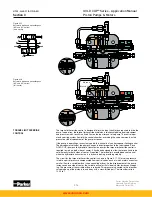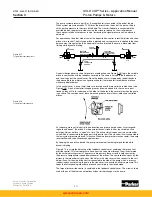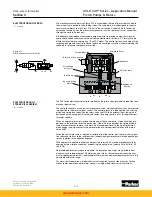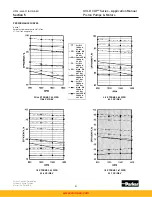
HY28-2668-01/GC/NA,EU
GOLD CUP
®
Series - Application Manual
Piston Pumps & Motors
4.4
Parker Hannifin Corporation
Hydraulic Pump Division
Marysville, Ohio USA
Section 4
GOLD CUP
®
series hydrostatic transmissions are capable of dynamically braking loads and
regenerating the horsepower back into the prime mover. Because of the pressure compensa-
tor override, the horsepower losses during dynamic braking will be minimal. The prime mover
must accept full braking loads.
Under dynamic braking modes of operation the pump and motor in a hydrostatic transmission
exchange functions. The motor, operating as a pump in this mode, has low pressure oil on its
inlet and high pressure oil on its outlet. It is therefore transferring horsepower from its shaft to
the hydrostatic loop. The pump, driven as a motor, converts hydraulic horsepower to mechani-
cal horsepower and feeds it into the prime mover. In this mode, the pump has high pressure
on its inlet and low pressure on its outlet.
Load absorption characteristics of prime movers are widely variant. Induction motors can gen-
erally absorb more horsepower than they can produce, while diesel engines will only absorb
20-30% of rated output. In some cases, the regenerative capabilities of the prime mover can
be increased with the addition of special devices (e.g., Jacobs brakes on diesels). Consult the
manufacturer of the prime mover if overhauling loads are to be encountered.
Component and system inefficiencies help dissipate some power and reduce the total regen-
erated horsepower seen by the prime mover. These losses include those of the gear boxes
(both pump drive and at the load) and any other losses in the load drive mechanism.
If excess regenerated horsepower will be presented to the prime mover and all efforts to
increase its absorption characteristics have been exhausted, other methods of energy dissi-
pation must be employed. For traction drives large manually operated service brakes may be
used to dissipate this energy. Other systems may have to use the hydraulic system to absorb
the energy in the form of heat.
Open circuit hydraulic systems will absorb this heat and carry it to the cooler, usually without
problem. Closed circuit systems will tend to hold the heat due to the small fluid exchange rate.
If high overhauling loads have to be absorbed by hydrostatic circuits, extra replenishment flow
should be added at a rate dictated by the heat rise expected in the loop.
For most applications, the replenishment flows available from the charge pump(s) contained
in the package pump are adequate. There are, however, many applications where additional
replenishment flows are necessary. These applications include:
(1) low input speeds
(2) systems with large compressible volume
(3) multiple actuators-unequal area actuators
(4) high leakage actuators
(5) systems with high pressure drops
As explained in Circuitry Section 2, the GOLD CUP
®
package pumps are capable of accept-
ing case drain oil in reverse to prevent cavitation. Case pressure replenishing is accomplished
by routing the actuator drain flow to the pump drain port and then routing both drain flows over
a 40 psi, 2,8 bar back pressure check. (See Figure 4.6)
OVERHAULING LOADS
DYNAMIC BRAKING
Figure 4.6
Case pressure replenishment
circuit
REPLENISHMENT
REQUIREMENTS
2,8 BAR
www.comoso.com






























